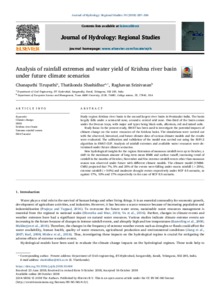Chanapathi, Tirupathi and T, Shashidhar and Raghavan, Srinivasan
(2018)
Analysis of rainfall extremes and water yield of Krishna river basin under future climate scenarios.
Journal of Hydrology: Regional Studies, 19.
pp. 287-306.
ISSN 2214-5818
![[img]](http://raiithold.iith.ac.in/4537/1.hassmallThumbnailVersion/Journal%20of%20Hydrology%20Regional%20Studies_19_287-306_2018.pdf)  Preview |
|
Text
Journal of Hydrology Regional Studies_19_287-306_2018.pdf
- Published Version
Download (19MB)
| Preview
|
Abstract
Study region: Krishna river basin is the second largest river basin in Peninsular India. The basin largely falls under a semi-arid zone, around a central arid zone. One-third of the basin comes under the Deccan traps, with major soil types being black soils, alluvium, red and mixed soils. Study focus: In the present study, SWAT has been used to investigate the potential impacts of climate change on the water resources of the Krishna basin. The simulations were carried out with the observed, historical, and future climate data of various climate models and the results were evaluated. The calibration and validation of the model was carried out using the SUFI-2 algorithm in SWAT-CUP. Analysis of rainfall extremes and available water resources were determined under future climate scenarios. New hydrological insights for the region: Extension of monsoon rainfall even up to October, a shift in the maximum amount of long-term mean ISMR and surface runoff, increasing trend of rainfall in the months of October, November and few extreme rainfall events other than monsoon season was observed under future with different climate models. The climate model (CNRM-CM5) projected that 7%, 5% and 25% of the events were falling under excess rainfall (>25%), extreme rainfall (>50%) and moderate drought events respectively under RCP 4.5 scenario, as against 17%, 10% and 17% respectively in the case of RCP 8.5 scenario.
Actions (login required)
 |
View Item |


 Altmetric
Altmetric Altmetric
Altmetric